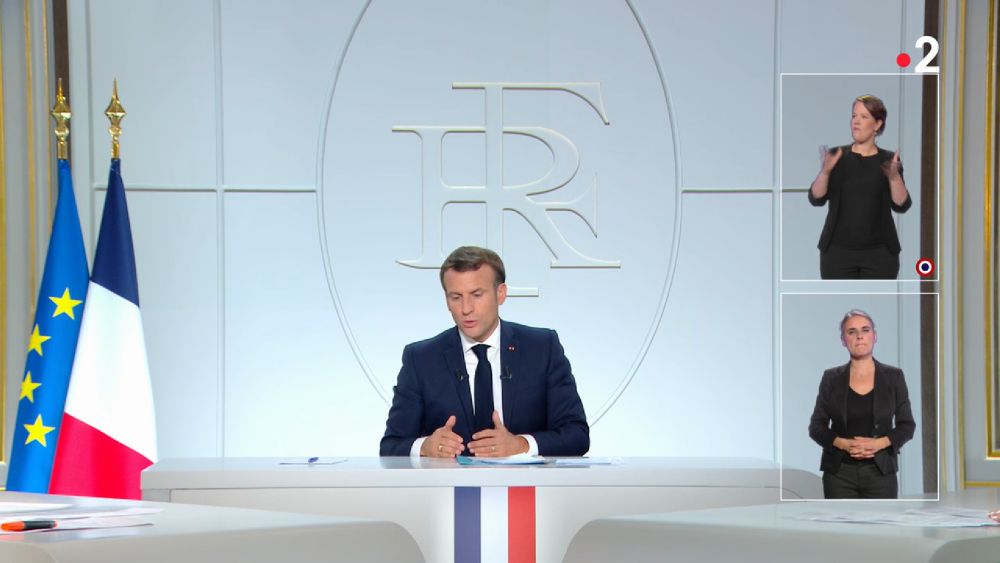Home | Daily Science: TOP 10 | TOP 10 BOOK (PDF)
By Christian Hoffmann &
Bernd S. Kamps
14 October
Prevention
Macron E. Curfew in France. France 2, October 14, 8 p.m. Link: https://www.france.tv/france-2/journal-20h00/1987881-edition-du-mercredi-14-octobre-2020.html
As we disclosed yesterday (see the comment on the paper by Andronico et al, https://covidreference.com/top-10-october-13; a great thanks to our contact at the Élysée Palace!), Emmanuel Macron, the French President, has announced this evening a 9 p.m. – 6 a.m. curfew of at least four weeks. The curfew which will be in place for four weeks from midnight on Saturday, October 17, affects around 20 million people (30% of the French population) in Île-de-France (literally “Island of France”) and eight other cities (Lille, Rouen, Saint-Etienne, Toulouse, Lyon, Grenoble, Aix-en-Provence and Montpellier). A lesson of science some other countries can only dream of.

Copyright: France 2. Reproduced with permission.
Epidemiology
Jefferies S, French N, Gilkison G, et al. COVID-19 in New Zealand and the impact of the national response: a descriptive epidemiological study. The Lancet 2020, published 13 October. Full-text: https://doi.org/10.1016/S2468-2667(20)30225-5
New Zealand’s government response resulted in low burden of disease, low levels of population disease disparities, and the initial achievement of COVID-19 elimination (Jefferies 2020, Robert 2020). Here, Sarah Jefferies et al. describe 1503 COVID-19 cases from Feb 2 to May 13, after which time community transmission ceased in New Zeeland, including 95 (6.3%) hospital admissions and 22 (1.5%) COVID-19 deaths. 1034 (69%) cases were imported or import related, tending to be younger adults, of European ethnicity, and of higher socioeconomic status. 702 (47%) cases were linked to 34 outbreaks.
See also the comment by Robert A. Lessons from New Zealand’s COVID-19 outbreak response. The Lancet 2020, published 13 October. Full-text: https://doi.org/10.1016/S2468-2667(20)30237-1
Immunology
Willyard C. How anti-ageing drugs could boost COVID vaccines in older people. Nature 2020, published 14 October. Full-text: https://www.nature.com/articles/d41586-020-02856-7
COVID-19 poses the greatest threat to older people, but vaccines often don’t work well in this group. Scientists hope drugs that rejuvenate the immune system will help. A Nature News Feature by Cassandra Willyard.
Poland GA, Ovsyannikova IG, Kennedy RB. SARS-CoV-2 immunity: review and applications to phase 3 vaccine candidates. Lancet 2020, published 13 October. Full-text: https://doi.org/10.1016/S0140-6736(20)32137-1
A mere 11 months ago, we didn’t know anything about SARS-CoV-2 and COVID-19. Now we are developing vaccines, antivirals, and monoclonal antibodies. In this review, the authors discuss what is known about human humoral and cellular immune responses to SARS-CoV-2 and relate this knowledge to the COVID-19 vaccines currently in phase 3 clinical trials. Will vaccines induce protective immunity? How long will this immunity maintained? Will we need multiple vaccine types for different populations (i.e., immune-immature infants, children, pregnant women, immunocompromised individuals, and immunosenescent individuals aged ≥65 years). Can unrelated vaccines (measles, mumps, and rubella vaccine and the Bacillus Calmette–Guérin vaccine) elicit trained innate immunity and confer protection against COVID-19? These are some of the questions you will explore with the authors.
Barnes CO, Jette CA, Abernathy ME, et al. SARS-CoV-2 neutralizing antibody structures inform therapeutic strategies. Nature 2020, published 12 October. Full-text: https://doi.org/10.1038/s41586-020-2852-1
To determine structural correlates of SARS-CoV-2 neutralization, the authors solved 8 new structures of distinct COVID-19 human neutralizing antibodies (hNAbs) in complex with SARS-CoV-2 spike trimer or the receptor-binding domain (RBD). Structural comparisons allowed classification into several categories according to which part of the spike protein’s cell-attachment region they recognize. These categories might later provide rules for assigning current and future human RBD-targeting antibodies into classes, evaluating avidity effects, suggesting combinations for clinical use, and providing insight into immune responses against SARS-CoV-2.
Collateral Effects
Been JV, Burgos Ochoa L, Bertens LCM. Impact of COVID-19 mitigation measures on the incidence of preterm birth: a national quasi-experimental study. Lancet Public Health 2020, published 13 October. Full-text: https://doi.org/10.1016/S2468-2667(20)30223-1
In this large national quasi-experimental study spanning a 10-year period, substantial reductions in preterm births were observed following implementation of the first national COVID-19 mitigation measures in the Netherlands on March 9, 2020. Babies born at the lowest gestational ages and those with the lowest birthweights were consistently underrepresented in our cohort throughout the study period.
Spanish
If you read Spanish, read
Ansede M. Seis personas entre 40 millones de casos: el misterio de los reinfectados por el coronavirus. El País, published 14 October. Full-text: https://elpais.com/ciencia/2020-10-13/seis-personas-entre-40-millones-de-casos-el-misterio-de-los-reinfectados-por-el-coronavirus.html
La comunidad científica duda si media docena de reinfecciones documentadas son excepciones o los primeros avisos de lo que será habitual en el futuro
Valdés I. “Era como intentar apagar un incendio en toda una ciudad con un cubo de agua” – El País 2020, published 14 October. Full-text: Full-text: https://elpais.com/sociedad/2020-10-13/era-como-intentar-apagar-un-incendio-en-toda-una-ciudad-con-un-cubo-de-agua.html
Miguel Sánchez, jefe de UCI en el hospital Clínico San Carlos de Madrid, coordina el equipo que gestiona desde marzo los traslados de enfermos graves entre los centros de la comunidad
